Clinical Center News
An inspiring return: Former patient revisits the Clinical Center
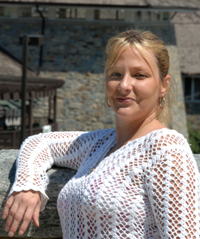 |
Melissa Tippins recently visited the Clinical Center, the place she credits with saving her life, after 19 years away. She was brought to NIH at age 2 (photo below, right) with Burkitt's Lymphosareoma.
|
Nearly 35 years after she came to the CC for treatment of a rare childhood cancer, Melissa Tippins returned to the center to bring her journey of self-discovery full circle.
Tippins, 37, of Hardeeville, S.C., was brought to Bethesda in 1974 with Burkitt’s Lymphosareoma. She stayed at the CC for four months through chemotherapy and radiation to kill the disease ravaging her small body, a cancer of the lymphatic system that presented as a tumor in Tippins’ abdomen.
The Savannah, Ga., native came to NIH within days of her diagnosis at a local hospital. Another local child with the cancer also made the trip, reported the Savannah Morning News.
Doctors caught Tippins’ cancer in time to cure her. She went into remission and returned south, but continued to visit the CC for monitoring until age 18. The only lingering physical effects of her Burkitt’s are osteoporosis and a scar across her abdomen, her “zipper.”
|

|
Melissa Tippins at age 2.
|
A recent trip to Virginia spurred Tippins to revisit the CC. “I’ve got goosebumps,” she said as she left Medical Records where she was given a copy of her file, the first she’d seen of her documented medical history. After a tour of the new pediatrics wing, Tippins returned to the 13th floor where she had spent a substantial part of her youth. Closed off these days, the former occupant peeked into a window.
“I know what it’s like to be told you have zero percent chance,” Tippins said. “I’m just living proof that miracles happen every day.”
She expressed real joy at the Children’s Inn and the Edmond J. Safra Family Lodge, both built since her time at the CC. Tippins recalled that the strain of separation was hard on her parents, but welcoming locals stepped forward to volunteer spare rooms and cottages to house her mother while Tippins was treated.
Tippins’ journey back to NIH helped her define her life’s purpose. “It’s made my will stronger,” said Tippins, who hopes to volunteer with families of suffering children.
Back to Top
New Biomechanics Director Joins the CC
 |
|
Dr. Diane Damiano, new director of biomechanics in the CC Department of Rehabilitation Medicine, comes from Washington University in St. Louis.
|
Dr. Diane Damiano joined the Clinical Center as director of biomechanics in July.
A physical therapist by training, Damiano holds a PhD in research methods/biomechanics from the University of Virginia, a master’s degree in physical therapy from Duke University, and an undergraduate degree in biological sciences from Catholic University. She comes from the Department of Neurology at Washington University in St. Louis.
Damiano is the recipient of numerous NIH grants and has published more than 50 papers in peer-reviewed journals. She is a member of the Musculoskeletal and Rehabilitiation NIH Study Section. A past president of the Clinical Gait and Movement Analysis Society, she is currently the president of the American Academy of Cerebral Palsy and Developmental Medicine, the first physical therapist in that role in its 61-year history.
Damiano’s area of expertise is investigation of both existing and novel rehabilitation approaches in children with cerebral palsy. She was one of the first researchers to recognize that spastic muscles were weak and needed strengthening, revolutionizing the treatment of these patients. Her more recent interest is in the role of physical activity in enhancing motor coordination and promoting neural recovery in those with brain injuries.
“Biomechanics laboratories are a perfect model of interdisciplinary collaboration where engineers, physicians, therapists and other scientists work in concert—each with unique perspectives and expertise that contribute equally to the combined research mission,” she said.
Her awards include the Hughes award from Pediatric Physical Therapy, the annual research award given to one faculty member per year from the American Physical Therapy Association Pediatrics Section; the best paper and best poster awards at the American Academy of Cerebral Palsy and Developmental Medicine annual meeting; and the Ethel Hausman Clinical Research Scholars Award from the United Cerebral Palsy Educational and Research Foundation.
Five years ago Damiano visited the CC Rehabilitation Medicine Department. “I remember thinking that NIH was clearly the best environment in the world for a scientist to work. The biomechanics laboratory is already well-positioned with state-of-the-art equipment and a small but growing group of innovative scientists who can push the frontiers of rehabilitation for children and adults with physical disabilities. Rehabilitation Medicine Department Chief Dr. Leighton Chan has a very innovative and forward-thinking vision for the entire department,” Damiano said.
She and her husband, Dr. Ralph Damiano, the chief of cardiac surgery at Washington University in St. Louis, have three children, Nick, Cara, and Devon.
Back to Top
‘I recognize that every day I am given is a blessing and a gift.’
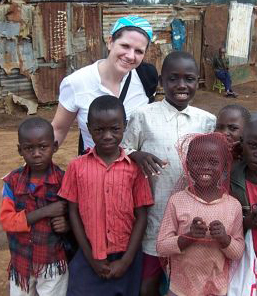 |
Heather Rhine, a nurse in the ICU, was impressed by the selflessness she encountered on a medical mission to Nairobi, Kenya, in 2006.
|
ICU nurse Heather Rhine never pictured herself as an overseas medical volunteer, but felt led to it through her involvement with her church.
Rhine, with 15 other church members, went on a 14-day medical mission trip to Nairobi, Kenya, in April 2006. The group treated more than 1,000 patients. With 16 bags of medications they fought the basic diseases, such as malaria, stomach problems, flu, and colds.
“Our first stop was in a slum on the outskirts of Nairobi called Kibera. I can’t even begin to explain what I saw and smelled,” Rhine recalled. “Yet despite their living conditions, these people were some of the most kind and loving people I’ve ever met. They weren’t bitter or angry about their lives.”
Rhine says it amazed her how the people of Africa are so welcoming. “They are selfless and want to share and give you what they have. It’s very humbling,” she said. “It really puts things in a new and fresh perspective for me.”
In November 2007, Rhine traveled to the Philippines with her mother and uncle, a missionary in Manila for 30 years, for a trip that combined both mission work and time with her family. She also plans to return to Africa during 2008.
Back to Top
Retirement Roundup: Darrick Gilmore and CAPT Sherry Meyers
Darrick Gilmore
After more than 30 years with the Department of Laboratory Medicine (DLM), Darrick J. Gilmore retired from his post as medical technologist on August 1 to spend more leisure time with his family.
Gilmore came to NIH as a laboratory assistant in 1975, the same year he graduated from Johnson C. Smith University, Charlotte, N.C. A year later he moved to phlebotomy in Clinical Pathology before settling in DLM in 1977. He has worked there since as a quality control specialist of microbiology media and specimen processing. Gilmore was a recipient of a 2006 CC Director’s Award for his contribution to his team.
“Darrick is a delight and a model employee—willing to do whatever he is asked and always with a smile. He will be missed greatly by the entire staff,” said Dr. Patrick Murray, chief of the DLM’s Microbiology Service.
While his retirement is bittersweet since he’ll be leaving the coworkers he refers to as family, Gilmore is excited to give someone else the opportunity to work at NIH. He leaves the campus community with the message: Attitude is everything.
Sherry Meyers
CAPT Sheryl “Sherry” Meyers ended a nearly straight 28-year run at the Clinical Center with her August retirement. After graduating from the Lincoln General Hospital School of Nursing, Lincoln, Neb., and joining the Air Force, Meyers came to the NIH as a staff nurse in the affective disorders unit in 1980. She holds a Bachelor of Science in Nursing from Marymount University, Arlington, Va., and a Master of Science in Nursing from the Catholic University of America School of Nursing.
Meyers served as nurse manager of the affective disorders unit for 13 years, in addition to stints in nursing recruitment and nursing orientation. After a tour of duty with the FDA, Meyers returned to the CC assisting Dr. David Henderson, deputy director for clinical care, with the patient safety study and then as a nursing consultant in the Department of Clinical Research Informatics.
She transitioned from civil service to the Public Health Service (PHS) Commissioned Corps in 1986, and her many PHS awards include the Chief Nurse Officer Award in 2002 and 2008. Even more than her CC Director’s Award (1999) and other service awards, though, Meyers is most proud of her creative recognition. Out of 1,354 entries, hers was the one chosen as the NIH Centennial Logo in 1985.
Meyers is planning a move to Colorado Springs in late fall or early spring, a favorite place from her childhood.
Back to Top
AJN article honored with Clarion Award
The American Journal of Nursing was awarded an Association for Women in Communications’ Clarion Award for the April 2007 article “Cancer Survivors, Prescription for Living.” Sandra Mitchell, PhD, CRNP, AOCN, senior research nurse specialist in the Clinical Center’s Research and Practice Development Service, co-authored the article, which provides a template for developing a cancer survivorship plan.
In 2005 the Institute of Medicine recommended that all cancer patients who have completed treatment be given a survivorship plan. The “Prescription for Living” provides an instrument clinicians can use to summarize the patient’s history of cancer treatment and tailor the survivorship care plan for initial and long-term follow-up, surveillance for recurrence, management of persistent effects, and screening and health promotion activities relevant to anticipated late effects.
Mitchell’s current research emphasizes preventive, restorative, and palliative rehabilitation during and after cancer treatment and highlights the effect of symptom burden on functional status. Her work also has been published in the Journal of Supportive Care in Cancer and Biology of Blood and Marrow Transplantation. In 2006 she received an NIH Clinical Center Director’s Award for Science and the Excellence in Oncology Nursing-Sensitive Patient Outcomes Award from the Oncology Nursing Society.
The Clarion Awards, recognizing excellence in communication across disciplines, will be presented at the 2008 Annual Association for Women in Communications National Conference Sept. 25-27, in Washington, D.C.
“Our whole team was just thrilled,” Mitchell said of the honor. “This award will hopefully help us to spread the message even wider about the contribution a cancer survivorship care plan can make to the delivery of quality cancer care.”
The article “Cancer Survivors, Prescription for Living” can be accessed at www.nursingcenter.com/AJNcancersurvivors.
Back to Top
Hope flows from one patient to another in summer art tile project
by Jenny Haliski
 |
A collection of some of the tiles created for the project.
|
A treasure chest of frustration. A lone goldfish swimming in a bowl. The word “hope” stretched across a sunrise.
These are just a few of the themes of masonite tiles decorated by Clinical Center patients as part of a project called “The Art of Healing: The patient tile project.” The Recreation Therapy Section’s goal for the summer project, which ran from June through August, was to collect 100 tiles filled with images and phrases that capture the personal symbols of patient experiences at the CC.
Patients saw the process as a way to make a statement about their experience of illness, have their voice heard, and give a thing of beauty back to the CC community.
The tiles were made at a drop-in clinic on Monday mornings. Megan Robb, a board certified art therapist at the CC, and Natalie Haynes, a certified recreation therapist, traveled to patient units so that patients who must remain in bed, connected to medical devices, or in isolation had a chance to participate.
Robb stressed that the tile project had been collaborative with the CC community since the beginning. The tile installation design and title came from a patient who is a professional artist. Several 1NW nurses suggested displaying tiles made by pediatric patients on their unit. Other staff across units were very supportive of hosting art clinics to create tiles specific to patient experiences, such as receiving donated blood stem cell transfusions to treat cancer or fighting alcoholism or mental illness.
The tiles will be displayed in a flowing wall installation. The theme—hope flows from one to another—expresses the critical importance of the support from the community at the CC, not just from staff, but from the patients themselves. Through the tile project, patients described how they rely on each other for understanding, strength, and friendship.
Patients created their tiles from copper cut-out shapes, game pieces with letters, paint, and a texturized modeling paste. Robb, the CC art curators, and the CC art committee are still deliberating about how to best tell the stories that accompany the tiles. Some patients wrote short descriptions of the significance of their work. Others wanted to display their names on the tiles and contribute to a book of testimonials.
Family members, caregivers, and staff helped patients create their tiles. “Creating a piece of art together breaks down the traditional roles and boundaries between staff and patients and lets us interact in new ways,” Robb said.
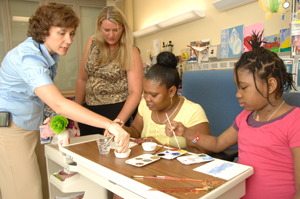 |
Megan Robb (left), a board certified art therapist, and Natalie Haynes, certified recreation therapist—both within the Rehabilitation Medicine Department's Recreation Therapy Section—help patient Danielle Harriott and her mom, Cassandra Christopher, create tiles for the project that remind them of their home in Kingston, Jamaica.
|
According to Robb, the tile project was a therapeutic art activity—it had a theme and an end product. Art therapy, on the other hand, is a client-driven process with an unknown destination that is rarely displayed in public. Although Robb believes that making art is an inherently healing process whatever the context, she feels that a particularly important aspect of this project was the opportunity for patients to communicate their experience to CC physicians and staff.
“It’s a good visual reminder for staff that receiving care here can be a simultaneously fearful and hopeful experience, where our patients may alternate between feeling powerful and vulnerable as they progress through their journey,” Robb said.
CC patient Danielle Harriott and her mom, Cassandra Christopher, created tiles for the project that remind them of their home in Kingston, Jamaica, which they have been away from for more than a year. They painted the green-blue color of the ocean, the white sandy beaches, and their country’s flag.
“We’re very glad to be here,” Christopher said. “If we hadn’t come here, we would have lost Danielle already.”
Back to Top
Change in requirements makes flu vaccine mandatory for staff with patient contact
As summer winds down, the leaves start to turn and thoughts turn to flu vaccinations. Available free of charge to all those with an NIH employee badge, the vaccine will be offered starting in October.
New this year, NIH has modified the flu vaccine requirements, making it mandatory for all NIH employees who have contact with Clinical Center patients. The Medical Executive Committee approved this new requirement in February 2008.
Those who are unable or unwilling to be vaccinated by OMS will be required to sign a declination form explaining the reason. Despite solid evidence that vaccinating health-care workers protects patients from influenza, the health-care workforce has a surprisingly low rate of influenza vaccination. An emerging consensus among public health experts has led the Centers for Disease Control and Prevention, the Infectious Diseases Society of America, The Joint Commission, and the Society for Healthcare Epidemiology of America to call for universal vaccination of health-care workers. In a concerted effort to promote patient safety and reduce the risk of hospital-based transmission of influenza, the CC has adopted this strategy. Health-care workers with medical contraindications or religious or philosophical objections to vaccination will submit declination forms.
The influenza vaccine for the 2008-2009 season contains the following strains recommended by the FDA’s Vaccines and Related Biological Products Advisory Committee: A/Brisbane/59/2007 (H1N1)-like virus, A/Brisbane/10/2007 (H3N2)-like virus, and B/Florida/4/2006- like virus. The vaccination schedule and locations will run in the October CC News and be posted on the Division of Occupational Health and Safety Web site http://foiltheflu.nih.gov. If you have questions about the influenza vaccine, please call the CC Hospital Epidemiology Service at 301-496-2209.
Back to Top
Patient thanks CC staff with concert
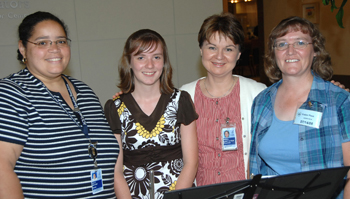 |
(from left): Joy Bryant, NHGRI nurse; Heidi Peck; Dr. Meral Gunay-Aygun, principal investigator for Heidi's study; and Heidi's mom, Debi Peck, gather in the CC atrium on July 16 to hear Heidi thank her support staff with a flute performance.
|
Clinical Center patient Heidi Peck, now a high school senior in Mountain Home, Idaho, has played the flute since she was in fifth grade. But doctors thought at one time that she might not play again.
Heidi has a type of kidney and liver disease that results in underdeveloped lungs in some patients. When Heidi’s mother Debi researched her daughter’s disease, she found the NIH protocol Heidi is currently enrolled in and contacted the doctors involved.
It was Heidi’s mom who thought of a concert as a way to thank CC staff. A range of clinical health professionals involved in Heidi’s care—principal investigator, liver specialist, pulmonary function technician, CC music therapist—the new friends she’s made at the Children’s Inn, and family members gathered in the atrium July 16.
“She’s an inspiration to all of us that, no matter what’s going on, you can still do what you love,” said NHGRI nurse Joy Bryant.
Although Heidi’s kidney function might decline over time, she says she currently feels fantastic and her doctors predict that she should be able to continue to play the flute for a very long time. Winner of several music performance competitions and college scholarships, Heidi is still deciding on a college, but plans to major in music performance. She is in her third year playing with the Treasure Valley Youth Symphony, part of the Boise Philharmonic.
Back to Top
When researchers become test subjects
There is a fairly untapped resource for clinical research volunteers—researchers themselves.
That was one message from Dr. Lawrence Altman during his Clinical Center Grand Rounds presentation in August, “Who Goes First? Self-Experimentation in Medicine, Revisited.” Altman is senior medical correspondent and columnist at The New York Times and clinical professor at the New York University School of Medicine’s Department of Internal Medicine.
Altman is the author of Who Goes First? The Story of Self-Experimentation in Medicine, and his talk covered the history and ethics of self-experimentation. He also reminded the staff and fellows gathered that today’s standard vaccines and treatments are yesterday’s trials.
Cited as one example was Nobel Prize winner Barry Marshall. In 1984, the Australian scientist swallowed a sample of the bacteria Helicobacter pylori to prove it caused gastritis, or stomach ulcers.
Altman noted that many who choose to try their hypothesis on themselves see it as a reflection of the Biblical Golden Rule: Do to others what you would have them do to you. Why should a volunteer not connected to a study go forward with an experiment, Altman asked, if the researcher is not willing to partake?
What if the trial pertains to a disease the scientist does not have? The first phase of Food and Drug Administration approval addresses the risk and safety of the proposed product, which researchers would be able to test on themselves, Altman said.
Altman touched on the criticism that self-experimentation invites a certain amount of bias into the research, but dismissed the claim, “Loss of objectivity is a concern in any experiment.”
Back to Top
Teen Retreat
 |

The CC Recreation Therapy Section, Department of Rehabilitation Medicine; and the Children's Inn welcomed patients age 12 to 25 to a Teen Retreat July 28 and 29. A concert by Inn staff and NIH patients entertained the group gathered at a pizza party on day two. Other retreat activities included art, music, and recreation therapy, and the Ultimate Teen Challenge. At left, staffers Alex Perry, Alex Flores, and Melissa Dutcher join Killian Mandfield and Ashley Appell in a performance of "Landslide." Above, Donna Gregory, recreation therapy chief, Neil Esarte (middle), and Brian Grayson take in the tunes.
|
Story 10 text.
Back to Top
Day honors super siblings of CC pediatric patients
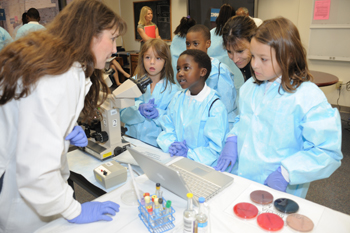 |
CC medical technologist Teresa Genson Bauch demonstrates to (from left) Lindsey Hancock, Shaquille Jones, Jolly Rop, and Emilie Hancock the importance of hand washing, as event organizer Dr. Lori Weiner peeks in to see what the kids are learning.
|
The Clinical Center Pediatric Clinic, NCI’s Pediatric Oncology Branch, and the Children’s Inn hosted a sibling day on July 15 to recognize and honor siblings aged 7—15 siblings of NIH pediatric patients.
Brothers and sisters of children enrolled in NCI, NIAID, NICHD, NHLBI, and NIMH protocols participated.
The group experienced the Department of Laboratory Medicine’s “Fantastic Voyage” demonstrations and a tour of the Department of Rehabilitation Medicine’s Biomechanics Laboratory. In therapeutic recreation activities, the kids shared their expertise as super siblings in the form of a newspaper advice column and made worry boxes to express what they might be experiencing as their patient sibling receives care.
At the end of the day, each sibling received a medal and a laminated certificate declaring them a “super sibling.” At the award ceremony, one boy said, “This is the best day of my entire life.”
Back to Top
Nursing interns graduate
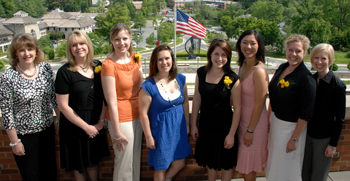 |
Kate Castro (far left), oncology clinical nurse specialist, and Rebecca Babb (far right), oncology educator, stand with the 2008 Oncology Nursing Internship program graduates (from left) Paul Bohaboy, Kristen Cole, Caitlin Carlock, Ashley Rodenbach, and Julie Brubake.
|
Two nurse internship programs held graduations in early summer. The Oncology Nurse Internship program celebrated its 20th graduating class on May 30. The program is designed to facilitate the transition of new graduate nurses into the oncology and clinical research nursing practice specialties. The 20-month curriculum includes oncology core curriculum content areas, professional development, simulation experiences, leadership training, clinical rounds, and off-site experiences. All of the interns achieved their national oncology nursing certification, a rare feat, prior to completing the internship.
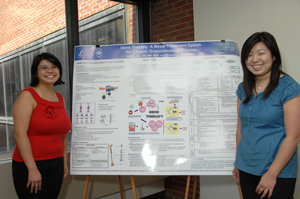 |
Graduates Christine Liu (left) and Hwalih Han stand at the Medical-Surgical Nurse Internship graduation with a poster they will present at an upcoming nurses' meeting.
|
The Medical-Surgical Nurse Internship program graduated two participants on June 13. Christine Liu and Hwalih Han completed the 20-month program providing a foundation for a future in their chosen specialty. The two will take their medical-surgical nurse certification exams at the Academy of Medical-Surgical Nurses 17th Annual Convention October 1—6 in Nashville, Tenn. Liu and Han will also present a poster on chronic granulomatous disease, on which they collaborated with NIAID principal investigator Dr. Elizabeth Kang, at the convention.
Back to Top
Participants, including healthy volunteers, sought for clinical trials
More information on the following studies can be found at http://clinicalstudies.info.nih.gov/ or by calling 1-866-444-2214 (TTY: 1-866-411-1010).
Dry mouth after cancer treatment? A clinical research study (06-D-0206) sponsored by the National Institute of Dental and Craniofacial Research will examine whether the experimental drug AdhAQP1 can increase salivary flow in patients whose parotid glands have been exposed to therapeutic radiation for treatment of head and neck cancer.
Asthma sufferer age 18 and 75? After positive experimental showings, a clinical research study (08-H-0047) sponsored by the National Heart, Lung, and Blood Institute will test whether a drug used to treat patients with diabetes is also effective in treating patients with asthma who do not respond to standard therapy. People aged 18—75 who have had asthma for at least one year are asked to participate. Compensation is provided.
Develop new treatments for allergies A clinical research study (05-I-0084) sponsored by the National Institute of Allergy and Infectious Diseases will evaluate children 6 months to 18 years of age with a possible diagnosis of asthma, food allergy, stinging insect allergy, and other allergic and inflammatory diseases in an attempt to gain information that may help to develop new treatments. Biological parents of patients may also be enrolled to provide a blood sample for genetic studies.
SmartPill: Interested? A clinical research study (08-DK-0138) sponsored by National Institute of Diabetes and Digestive and Kidney Diseases will test a new, non-invasive method, swallowing a small SmartPill, of measuring stomach acid secretion. Healthy volunteers between 18 and 60 years of age may be eligible. Compensation is provided.
Healthy? A woman? Age 30 to 50? A clinical research study (04-CH-0056) sponsored by the National Institute of Child Health and Human Development is looking for healthy women ages 30 to 50 to investigate the role of hormones and genes in pelvic pain and explore better approaches to treatment. Compensation is provided.
Got a pain in the neck? A clinical research study (02-CC-0245) sponsored by the Clinical Center seeks individuals age 18 to 65 with or without neck pain for a three-month natural history study of neck pain.
Back to Top
News Briefs
IPPCR course registration opens
Introduction to the Principles and Practice of Clinical Research (IPPCR), a course on how to design a successful clinical trial, will begin October 27 and run through March 17. Open to all at no cost, the class will be held on the NIH campus Monday and Tuesday evenings from 5 pm to approximately 6:30 pm. Registration closes October 17.
IPPCR is a product of the Office of Clinical Research Training and Medical Education and pulled more than 800 registrants for the 2007-2008 session. This course will be of interest to physicians and other health professionals planning a career in clinical research.
Students will cover components of clinical research such as epidemiologic methods, required infrastructure in developing and funding studies, and ethical and legal issues. Regulations involved in human subjects research, including the role of IRBs in clinical research, and the principles of monitoring patient-oriented research will also be addressed.
While the course is free, the textbook “Principles and Practice of Clinical Research, Second Edition” is suggested as supplemental reading. A certificate will be awarded upon completion of the course, based on a final exam.
Additional information, including registration, is available at http://www.cc.nih.gov/training/training/ippcr.html or 301-496-9425.
Sickle-cell walk to raise funds
The National Stomp Out Sickle Cell Walk will take place Saturday, September 20 from 8 - 10 am. The event works to improve the lives of those affected by sickle-cell disease through increased awareness, outreach and education. Coordinated by a number of community-based groups and medical institutions, the 3K walk will begin and end at Howard University with a midpoint of the Children’s National Medical Center. To register for the walk or make a donation, visit www.soswalk.org, call 301-292-3682, or e-mail info@soswalk.org.
Parking changes across campus
With the majority of visitor parking eventually transitioning to the new MLP-11 Gateway Center parking garage, the NIH has implemented new parking policies throughout campus. When parking attendants are on duty; where attendant (stack) parking is available; after-hours key pick-up procedures; and metered parking at various lots are all subject to change.
Some of these changes will amount to a decrease in overall stack parking, but should be offset by visitor lots converting to employee parking on campus. All visitor parking, with the exception of patient/patient visitor parking and metered spaces, will eventually transfer to MLP-11. The number of metered parking spaces on campus will grow from approximately 75 to 130.
The NIH Employee Campus Map (http://parking.nih.gov/employee_access_map.htm) and the NIH Visitor Map (http://parking.nih.gov/visitor_access_map.htm) reflect the updates.
Town hall meeting on new BTRIS program
 |
Join Dr. Jim Cimino, chief of the Clinical Center’s Laboratory for Informatics Development, for a presentation and demo of the new Biomedical Translational Research Information System (BTRIS) September 16 from 2–3 pm in Lipsett Amphitheater.
BTRIS is a powerful tool helping investigators access clinical and research data, develop streamlined mechanisms for protocol reporting and data analysis, and reuse data for hypothesis generation and collaboration.
The town hall meeting will be videocast at videocast.nih.gov. For continuing BTRIS news and information, visit btris.nih.gov.
|
NIH recognizes Lasker recipients
Members of the NIH intramural research community who have received a prestigious Albert Lasker Medical Research Award are recognized in a new exhibit on the first floor of the Clinical Center. It’s in the hallway east of the clinic elevators. Since 1945, Lasker awards have recognized the contributions of scientists, physicians, and public servants who have made major advances in the understanding, diagnosis, treatment, cure, and prevention of human disease. Seventy-five Lasker Award recipients have gone on to win a Nobel Prize.
The Lasker awards are administered by the Albert and Mary Lasker Foundation. Mary Woodard Lasker (1901–1994) was a champion of medical research. She and her husband, pioneer advertising executive Albert Davis Lasker (1880–1952), established a legacy of philanthropy and public support of important causes. Mrs. Lasker, recognized for her singular contribution to the growth of the National Institutes of Health, once said: "If you think research is expensive, try disease!"
Back to Top
New clinical research protocols
The following new clinical research protocols were approved in July:
Computer-Assisted Self-Administration of Ethanol (CASE) in Humans, 08-AA-0178, Vijay A. Ramchandani, Ph.D., NIAAA
A Pilot Study of Sirolimus (Rapamycin, Rapammune[Registered Trademark]) in Subjects with Cowden Syndrome or Other Syndromes Characterized by Germline Mutations in PTEN, 08-C-0151, Phillip A. Dennis, M.D., NCI
A Phase I Study of VEGF Trap (NSC #724770, IND #100137) in Children with Refractory Solid Tumors, 08-C-0179, Elizabeth Fox, M.D., NCI
Phase I Trial of the Raf Kinase and Receptor Tyrosine Kinase Inhibitor Sorafenib (BAY 43-9006, Nexavar) in Children and Young Adults with Neurofibromatosis Type 1 and Inoperable Plexiform Neurofibromas, 08-C-0180, Brigitte C. Widemann, M.D., NCI
A Trial of Segmental Stiffening Wires to Improve the Efficiency and Patient Tolerability of Colonoscopy, 08-DK-0173, Stephen A. Wank, M.D., NIDDK
Viral Kinetics and Liver Gene Expression in Response to Ribavirin and Peginterferon Therapy of Chronic Hepatitis C, 08-DK-0182, Jordan Feld, M.D., NIDDK
Natural History and Pathophysiology of Gastrointestinal Graft-Versus-Host Disease, 08-DK-0187, Stephen A. Wank, M.D., NIDDK
Pilot Study of the Evaluation of Sirolimus in the Treatment of Diabetic Macular Edema, 08-EI-0175, Catherine Meyerle, M.D., NEI
Multicenter International Lymphangioleiomyomatosis Efficacy of Sirolimus Trial (The MILES Trial), 08-H-0177, Joel Moss, M.D., NHLBI
Technical Development of Interventional Cardiovascular Magnetic Resonance Imaging in Normal Volunteers, 08-H-0185, Robert J. Lederman, M.D., NHLBI
Safety and the Anti-Tumor Effects of Escalating Doses of Adoptively Infused Ex Vivo Expanded Autologous Natural Killer (NK) Cells Against Metastatic Cancers or Hematological Malignancies Sensitized to NK –TRAIL Cytotoxicity with Bortezomib, 08-H-0186, Richard W. Childs, M.D., NHLBI
Studies in the Pathogenesis of Idiopathicc Anaphylaxis, 08-I-0184, Hirsh D. Komarow, M.D., NIAID
Role of Neurotransmission and Functional CNS Networks in Spasmodic Dysphonia, 08-N-0181, Kristina B. Simonyan, M.D., NINDS
The Relationship Between Temporal Discrimination and Cortical Excitability in Humans, 08-N-0189, Mark Hallett, M.D., NINDS
Back to Top
Upcoming Events
Clinical Center Grand Rounds for Clinical Fellows
September 3, 2008
Th2 Pathway Activation in Asthma: Closing the Loop
Sally E. Wenzel, MD
Director, Asthma and Allergic Diseases Center
Professor of Medicine, Division of Pulmonary, Allergy and Critical Care Medicine, University of Pittsburgh
Identifying New Therapeutic Strategies for Severe Asthma
Stewart J. Levine, MD
Chief, Asthma and Lung Inflammation Section, Pulmonary and
Vascular Medicine Branch, NHLBI
September 10, 2008
Contemporary Clinical Medicine: Great Teachers
Stroke Care: Present and Future Therapy
Brett Kissela, MD
Associate Professor of Neurology
University of Cincinnati College of Medicine
Lecture will be videocast, http://videocast.nih.gov
September 17, 2008
Bronchiolitis Obliterans After Allogeneic Hematopoietic Stem Cell Transplantation – An Increasingly Recognized Manifestation of Chronic Graft-Versus-Host Disease
Steven Pavletic, MD
Head, Graft-Versus-Host and Autoimmunity Unit
Experimental Transplantation and Immunology Branch, NCI
Kirsten Williams, MD
Assistant Clinical Investigator, Experimental Transplantation and Immunology Branch, NCI
Jason Chien, MD
Assistant Professor of Medicine, Division of Pulmonary and Critical Care, University of Washington
September 24, 2008
Sarcoidosis: Clinical Presentation, Epidemiology, and Genetics
Michael Iannuzzi, MD
Professor and Chair of Medicine
Pulmonary/Critical Care Division
SUNY Upstate Medical University and University Hospital, Syracuse, NY
Sarcoidosis: Immunopathogenic Concepts and Their Clinical Application
Joseph Fontana, MD
Medical Director, Pulmonary Function Laboratory, NHLBI/Pulmonary and Vascular Medicine Branch
Back to Top
Clinical Center News, National Institutes of Health, Building 10, 10 Center Drive, Room 12C440, Bethesda, MD 20892-1504. Tel: 301-496-6787. Fax: 301-402-2984. Published monthly for CC employees by the Office of Communications, Patient Recruitment, and Public Liaison. News, article ideas, calendar events, letters, and photographs are welcome.
Back to Top
|
This page last updated on 12/14/2017


 The information on this page is archived and provided for reference purposes only.
The information on this page is archived and provided for reference purposes only.